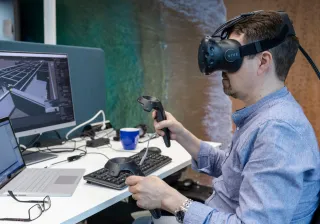When Finns are asked about the most important features of work, a good workplace atmosphere and, above all, coworkers are emphasised almost without exception. Community and people are important to us: we know that a good coworker gets the job done, can be trusted and sometimes you even have fun together. Many look on with concern at the revolution of artificial intelligence (AI) and automation, with computer algorithms replacing our tasks one after another. Fortunately, this kind of direct replacement of existing jobs is unlikely. Instead, it is more about enhancing work and improving its quality by means of AI systems: in many tasks, AI really becomes a new coworker with which we need to learn to work together.
We gradually get to know our coworkers at meetings, during coffee breaks and on business trips, and eventually we are able to quite accurately predict how they will act in different situations. But what happens when an AI system becomes one of your coworkers? How can you get to know it and learn to trust it? AI has already become part of many routine tasks: productivity, safety and meaningfulness of work are improved by automating repetitive work. When it comes to assigning more demanding and complicated tasks to AI, our interactions with technology also become more complex.
To understand the shift, we can utilise past experience of the development of automation systems in which the interaction between man and machine is described using the concept of situational awareness. Situational awareness is established by observing the environment; based on our observations, we try to understand the situation and assess its direction of development. In the context of automation systems, this is called automation awareness: in addition to general situational awareness, a person working with automation needs an understanding of the status of the automation system and any expected changes to it. However, in the future, automation awareness will no longer be enough; instead, we require new kinds of abilities from both the systems and the people using them.
You have to understand your coworker
In the future, we will talk about AI awareness, meaning the user’s ability to follow the decision-making of AI, to understand its decisions and their grounds and to evaluate its the future activities and decisions. The use of AI in working environments is increasing rapidly and discussion on the subject is constantly heating up. With the concept of AI awareness, we aim to structure the discussion and facilitate the building of functional AI systems. AI awareness is influenced by similar things to working with a human: you also have to understand AI, be able to communicate with it and trust its actions.
The intelligibility and transparency of artificial intelligence’s decision-making can be improved, for example, by means of simplifications and visualisations. The user can be presented with alternative possibilities for a decision as well as the grounds for choosing between them. In some cases, it may be useful to visually illustrate the chain of reasoning that led to a particular outcome. AI is often based on some sort of calculation of probability – presenting all the background variables and calculations clearly to the user may be difficult, but at least the system could on some level indicate on how high a probability a particular decision is based.
AI awareness also includes functional communication between the user and AI system. Artificial intelligence must be able to tell the user what the system is and is not capable of, what its current status is and what it plans to do next. In addition, it must be able to listen to the user and take the user’s instructions into account. Artificial intelligence’s ability for discourse is improving all the time as the techniques for processing natural language develop. It is also possible to utilise more and more versatile multimodal user interfaces.
The ability to interact must be ensured in the development of artificial intelligence
Intelligibility and communication are also the foundation for building trust in AI. Reaching a suitable level of trust is not without problems: the user cannot trust the system if it does not clearly communicate its intentions to the user or if its actions are difficult to understand. On the other hand, a system simplified to the extreme can be mistaken for being more capable than it is. A suitable level of trust in AI can only be built in stages as more and more demanding tasks are gradually assigned to it.
We are just taking the first steps towards AI awareness, but it is certain that AI will become a new coworker to increasing numbers of people. That is why it is important for us to understand, both as users and developers, the specific characteristics of the interaction between AI and humans. Some issues can be solved through technology, others require more extensive reform of working methods and organisations. Artificial intelligence is unlikely to ever completely replace people, but with careful planning, it is possible to ensure that it becomes, above all, a useful and pleasant coworker – and, one day, why not also something fun and humorous to brighten the coffee break?






